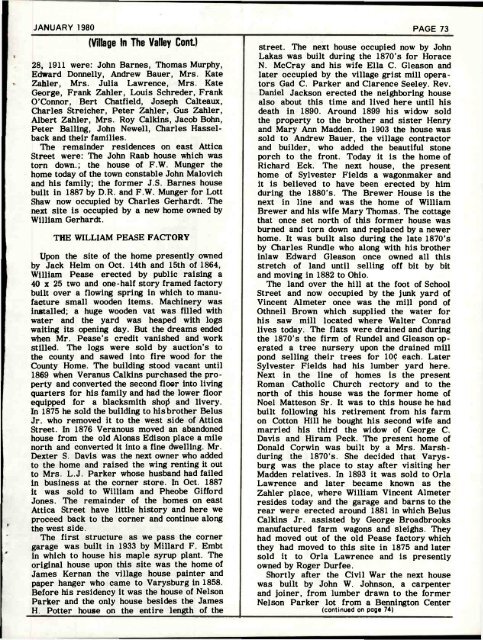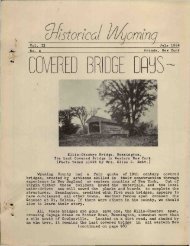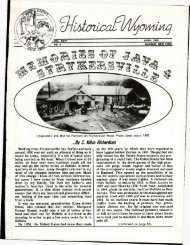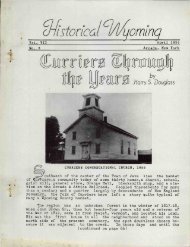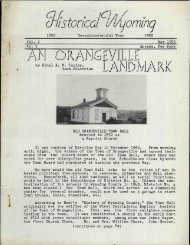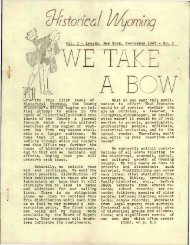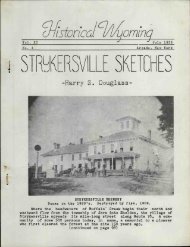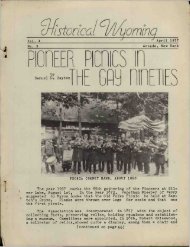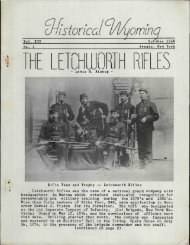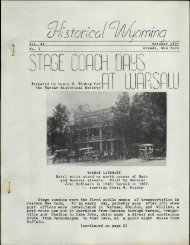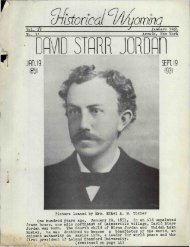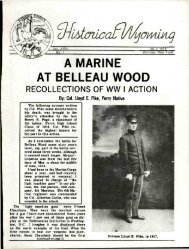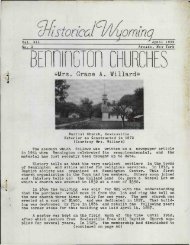Historical Wyoming County Jan 1980 - Old Fulton History
Historical Wyoming County Jan 1980 - Old Fulton History
Historical Wyoming County Jan 1980 - Old Fulton History
Create successful ePaper yourself
Turn your PDF publications into a flip-book with our unique Google optimized e-Paper software.
JANUARY <strong>1980</strong> PAGE 73<br />
(Village In The Valley Cont)<br />
28, 1911 were: John Barnes, Thomas Murphy,<br />
Edward Donnelly, Andrew Bauer, Mrs. Kate<br />
Zahler, Mrs. Julia Lawrence, Mrs. Kate<br />
George, Frank Zahler, Louis Schreder, Frank<br />
O'Connor, Bert Chatfield, Joseph Calteaux,<br />
Charles Streicher, Peter Zahler, Gus Zahler,<br />
Albert Zahler, Mrs. Roy Calkins, Jacob Bohn,<br />
Peter Balling, John Newell, Charles Hasselback<br />
and their families.<br />
The remainder residences on east Attica<br />
Street were: The John Raab house which was<br />
torn down.; the house of F.W. Munger the<br />
home today of the town constable John Malovich<br />
and his family; the former J.S. Barnes house<br />
built in 1887 by D.R. and F.W. Munger for Lott<br />
Shaw now occupied by Charles Gerhardt. The<br />
next site is occupied by a new home owned by<br />
William Gerhardt.<br />
THE WILLIAM PEASE FACTORY<br />
Upon the site of the home presently owned<br />
by Jack Helm on Oct. 14th and 15th of 1864,<br />
William Pease erected by public raising a<br />
40 x 25 two and one-half story framed factory<br />
built over a flowing spring in which to manufacture<br />
small wooden items. Machinery was<br />
installed; a huge wooden vat was filled with<br />
water and the yard was heaped with logs<br />
waiting its opening day. But the dreams ended<br />
when Mr. Pease's credit vanished and work<br />
stilled. The logs were sold by auction's to<br />
the county and sawed into fire wood for the<br />
<strong>County</strong> Home. The building stood vacant until<br />
1869 when Veranus Calkins purchased the property<br />
and converted the second floor into living<br />
quarters for his family and had the lower floor<br />
equipped for a blacksmith shoji and livery.<br />
In 1875 he sold the building to his brother Belus<br />
Jr. who removed it to the west side of Attica<br />
Street. In 1876 Veranous moved an abandoned<br />
house from the old Alonas Edison place a mile<br />
north and converted it into a fine dwelling. Mr.<br />
Dexter S. Davis was the next owner who added<br />
to the home and raised the wing renting it out<br />
to Mrs. L.J. Parker whose husband had failed<br />
in business at the corner store. In Oct. 1887<br />
it was sold to William and Pheobe Gifford<br />
Jones. The remainder of the homes on east<br />
Attica Street have little history and here we<br />
proceed back to the corner and continue along<br />
the west side.<br />
The first structure as we pass the corner<br />
garage was built in 1933 by Millard F. Embt<br />
in which to house his maple syrup plant. The<br />
original house upon this site was the home of<br />
James Kernan the village house painter and<br />
paper hanger who came to Varysburg in 1858.<br />
Before his residency it was the house of Nelson<br />
Parker and the only house besides the James<br />
H. Potter house on the entire length of the<br />
street. The next house occupied now by John<br />
Lakas was built during the 1870's for Horace<br />
N. McCray and his wife Ella C. Gleason and<br />
later occupied by the village grist mill operators<br />
Gad C. Parker and Clarence Seeley. Rev.<br />
Daniel Jackson erected the neighboring house<br />
also about this time and lived here until his<br />
death in 1890. Around 1899 his widow sold<br />
the property to the brother and sister Henry<br />
and Mary Ann Madden. In 1903 the house was<br />
sold to Andrew Bauer, the village contractor<br />
and builder, who added the beautiful stone<br />
porch to the front. Today it is the home of<br />
Richard Eck. The next house, the present<br />
home of Sylvester Fields a wagonmaker and<br />
it is believed to have been erected by him<br />
during the 1880's. The Brewer House is the<br />
next in line and was the home of William<br />
Brewer and his wife Mary Thomas. The cottage<br />
that once set north of this former house was<br />
burned and torn down and replaced by a newer<br />
home. It was built also during the late 1870's<br />
by Charles Rundle who along with his brother<br />
inlaw Edward Gleason once owned all this<br />
stretch of land until selling off bit by bit<br />
and moving in 1882 to Ohio.<br />
The land over the hill at the foot of School<br />
Street and now occupied by the junk yard of<br />
Vincent Almeter once was the mill pond of<br />
Othneil Brown which supplied the water for<br />
his saw mill located where Walter Conrad<br />
lives today. The flats were drained and during<br />
the 1870's the firm of Rundel and Gleason operated<br />
a tree nursery upon the drained mill<br />
pond selling their trees for 10£ each. Later<br />
Sylvester Fields had his lumber yard here.<br />
Next in the line of homes is the present<br />
Roman Catholic Church rectory and to the<br />
north of this house was the former home of<br />
Noel Matteson Sr. It was to this house he had<br />
built following his retirement from his farm<br />
on Cotton Hill he bought his second wife and<br />
married his third the widow of George C.<br />
Davis and Hiram Peck. The present home of<br />
Donald Corwin was built by a Mrs. Marshduring<br />
the 1870's. She decided that Varysburg<br />
was the place to stay after visiting her<br />
Madden relatives. In 1893 it was sold to Orla<br />
Lawrence and later became known as the<br />
Zahler place, where William Vincent Almeter<br />
resides today and the garage and barns to the<br />
rear were erected around 1881 in which Belus<br />
Calkins Jr. assisted by George Broadbrooks<br />
manufactured farm wagons and sleighs. They<br />
had moved out of the old Pease factory which<br />
they had moved to this site in 1875 and later<br />
sold it to Orla Lawrence and is presently<br />
owned by Roger Durfee.<br />
Shortly after the Civil War the next house<br />
was built by John W. Johnson, a carpenter<br />
and joiner, from lumber drawn to the former<br />
Nelson Parker lot from a Bennington Center<br />
(continued on page 74)


